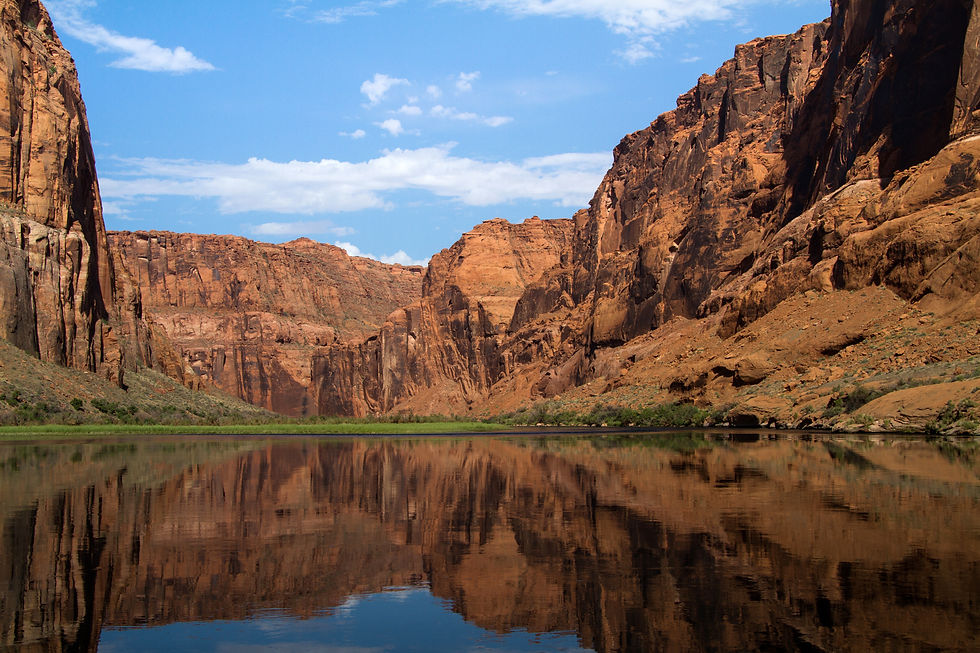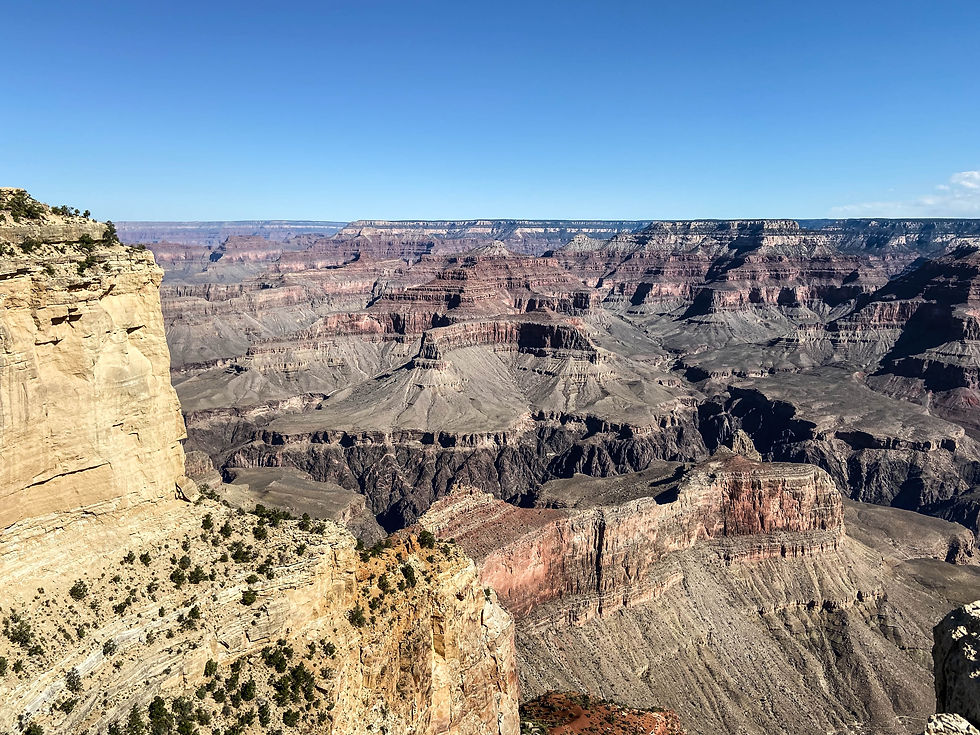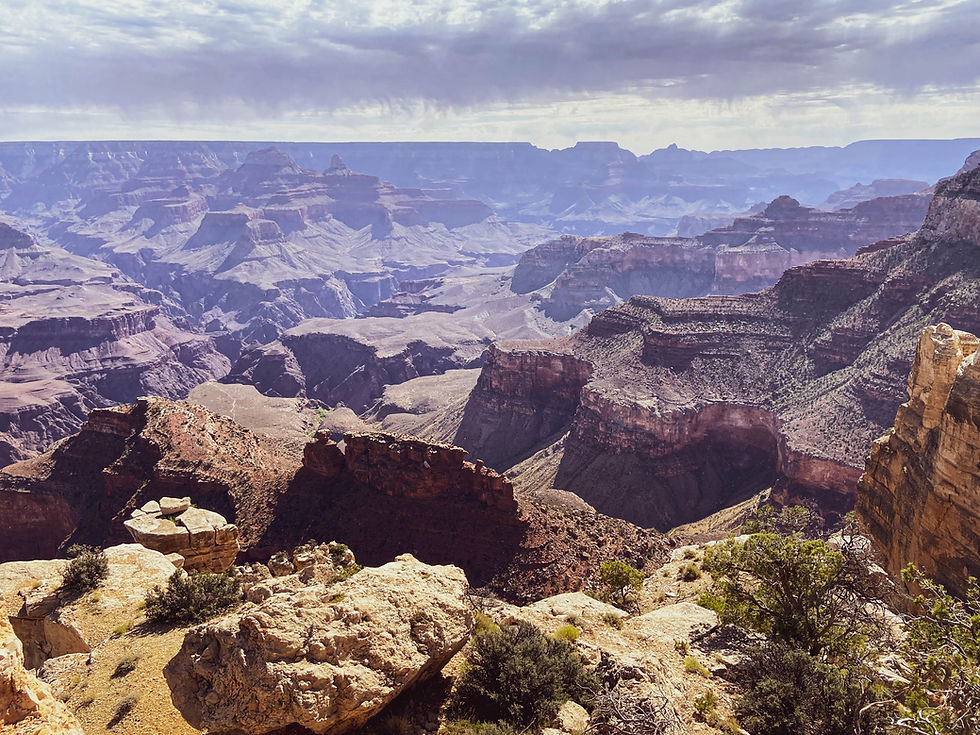GEOLOGY IN THE GRAND CANYON
When you stand on the rim of the Grand Canyon and look at the stratification lines, you are looking back millions of years with each layer. The Colorado River and the weather have exposed millions of years of the Earth’s history layer upon layer. The Grand Canyon, as with most canyons, is the result of erosion and not ice aged glaciers. In other words, it has been shaped by water over the last million years. Learn about dinosaur fossils, the Colorado river, the various rock formations and the history of the Grand Canyon.



With time and water, everything changes
Gerry Paulus
What happens to the Colorado River once it exits the Grand Canyon? The Colorado River runs out of the Grand Canyon on the Western edge of the National Park as it flows through the Grand Wash Cliffs. It flows into the Hoover Dam which was completed in 1935 and which, in turn, created Lake Meade. Lake Meade is the home of one of the largest hydroelectric generating plants in the US and it is sure to put you in awe. It is well worth a visit! The water in the lake is used for recreation first and once released, it generates 2.080 gigawatts of power before it is released for irrigation of crops on its onward trip to Mexico. The Colorado river is the outflow of high mountain streams from the Rocky mountains. an one river meet the needs of the human demands?
Geology of the Canyon
The history of the Grand Canyon is much older than six million years and it keeps evolving as scientists continue to unravel the mysteries of the Canyon and the Colorado River. For 65 million years the Rocky Mountains and the Colorado Plateau have been rising while the Colorado and other sheet flow events have been carving the Grand Canyon deeper into the Earth's past. It has cut so deep that as we look at the lowest layers in the Grand Canyon we are looking back a billion years at the Vishnu Basement Rock (1.84 to 1.66 billion years). As your eyes move up from the lowest layers you pass through the Chuar Group (0.78 to 0.73 billion years) up to the Paleozoic Strata (541 to 252 million years). From top to bottom each layer describes an era from the Kaibab Formation, the Toroweap, Coconino Sandstone, Hermit Formation, Supai group, Redwall Limestone, Muav Limestone, Bright Angel Shale, Tapeats Sandstone and sixty mile formation. Each layer is a defined period in the history of the canyon but all are sedimentary rock structures which clearly show the evolution of the planet. Below this era, we see additional Shinumo sandstones and the transition to Vishnu Schist, Cardenas Basalt, gneiss and Zoroaster Granite.
When you look out into and over the Grand Canyon, you might not even notice the prehistoric life right beneath your feet in the Kaibab limestone along the rim. When you stand on the rim of the canyon, you’re on top of a 270-million-year-old sea floor.
All around Arizona, rocks hold remains of life that lived hundreds of millions of years ago. When people think of fossils, dinosaurs typically come to mind — but that’s only one part of our history. Scientists have discovered fossils of microbes, sea sponges, insects, sharks, early amphibians and mammals in the rocks around the state of Arizona, representing over 1 billion years of life on Earth.
Water in and around the Grand Canyon in this semi-arid environment is sparse and even when it rains on the plateau the runoff percolates and seeps through porous, faulted and broken rock as it makes its way into the Grand Canyon. The Canyon has over 700 seasonal and perennial springs that emerge from limestone and caves over 3500 feet below the rim in the Eastern Grand Canyon. The Colorado River is a great source of water and it is used to supply communities in Arizona, Nevada and California for domestic, agriculture and recreation. The canyon does have a pipeline that was constructed in the 1960's that supplies water to Phantom Ranch and the rim communities.
Petrified Forest in Arizona outside of Holbrook, Arizona
Some fossils can be observed in the Petrified Forest National Park in Arizona such as the skull of a phytosaur, an extinct creature that lived during the Late Triassic. Rock analysis is being conducted by scientists from the University of Texas Institute for Geophysics to identify more accurately which geological period the reptile lived.
Here's a few interesting articles if you would like to know more about fossils in Arizona and where to find them.
Can I find dinosaur fossils in the Grand Canyon?
With over 1 billion years of the planet’s history preserved in the Grand Canyon, many kinds of lifeforms are represented in the rocks there — but no dinosaurs. The youngest rock layer in the canyon, the Kaibab Limestone on the rim, is about 270 million years old, which is older than the dinosaurs.



What happens if I find a fossil in the Grand Canyon National Park?
The Grand Canyon Visitor center often displays fossils, but with COVID-19 closures limiting access to indoor spaces, the best place to easily see fossils outdoors is the Grand Canyon National Park as you walk and search along the rim. The locations of fossils can rarely be found on maps to protect them from being damaged. Keep in mind that fossils and trace fossils such as footprints are irreplaceable resources, so be careful not to take petrified wood or fossils from the National Park, as it is illegal.
If you find a fossil while hiking in the Grand Canyon, park palaeontologists advise you to take a picture of it, record the coordinates and let a ranger know so a palaeontologist can analyze the specimen.
Weather on the South Rim of the Canyon
The rim gets less than 15" (38 cm) of precipitation annually and only Pinyon, Juniper trees and low vegetation can survive. Both of these trees have small leaves that minimize the surface area and evapotranspiration from the plant. Yucca cactus with their shinny, waxy stalks hold moisture and their strong roots pull from the dry soil on the rim. Further from the rim, the soil gains in quality and the moisture content is improved to sustain Ponderosa pine and other flora.
A short rim walk of a mile or two will take you from the Yavipai lodge to Mather point and beyond. At Mather Point you can get a glimpse of the Colorado River and Phantom Ranch Campgrounds.



